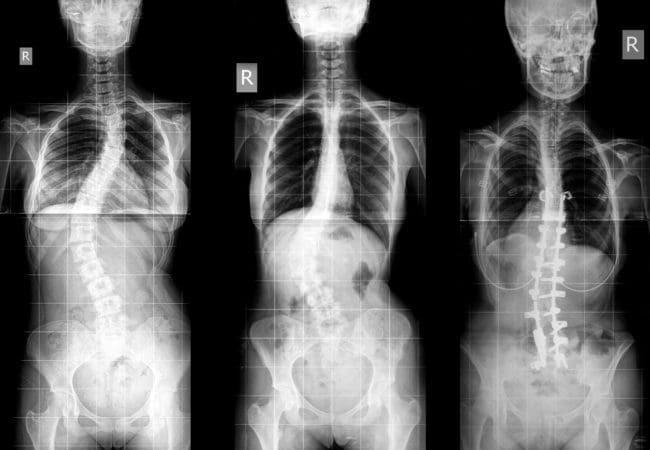Scoliosis Treatment?
Scoliosis Treatment: Scoliosis is defined as a curve of the spine of 10 degrees. Scoliosis causes an abnormal side-to-side “C” or “S” shaped curve to the spine. It can affect any part of the spine, but the chest and lower back areas are the most common areas. However, doctors offer various scoliosis treatment options and exercises/rehabilitation programs that patients can do at home or the gym.
Scoliosis often appears in children. For most cases, treatment is not needed, as the curve corrects itself as the child grows. However, based on the degree of curvature and the child’s age, a combination of bracing and physical/chiropractic therapy is recommended.
Table of Contents
Types
Types of scoliosis:
- Congenital Scoliosis: The spine does not form correctly before birth
- Early-Onset Scoliosis: Appears between birth and 10 years old
- Adolescent Idiopathic Scoliosis: Occurs as the child grows and leads to curving and twisting of the spine
- Degenerative Scoliosis: Affects adults due to wear and tear on the skeletal system
- Neuromuscular Scoliosis: Occurs from a problem/s with the muscles or nervous system
- Scheuermann’s Kyphosis: The front sections of vertebrae grow slower than the back sections, making them smaller
- Syndromic Scoliosis: This is linked to one of a range of syndromes, which include Marfan’s syndrome and Trisomy 21
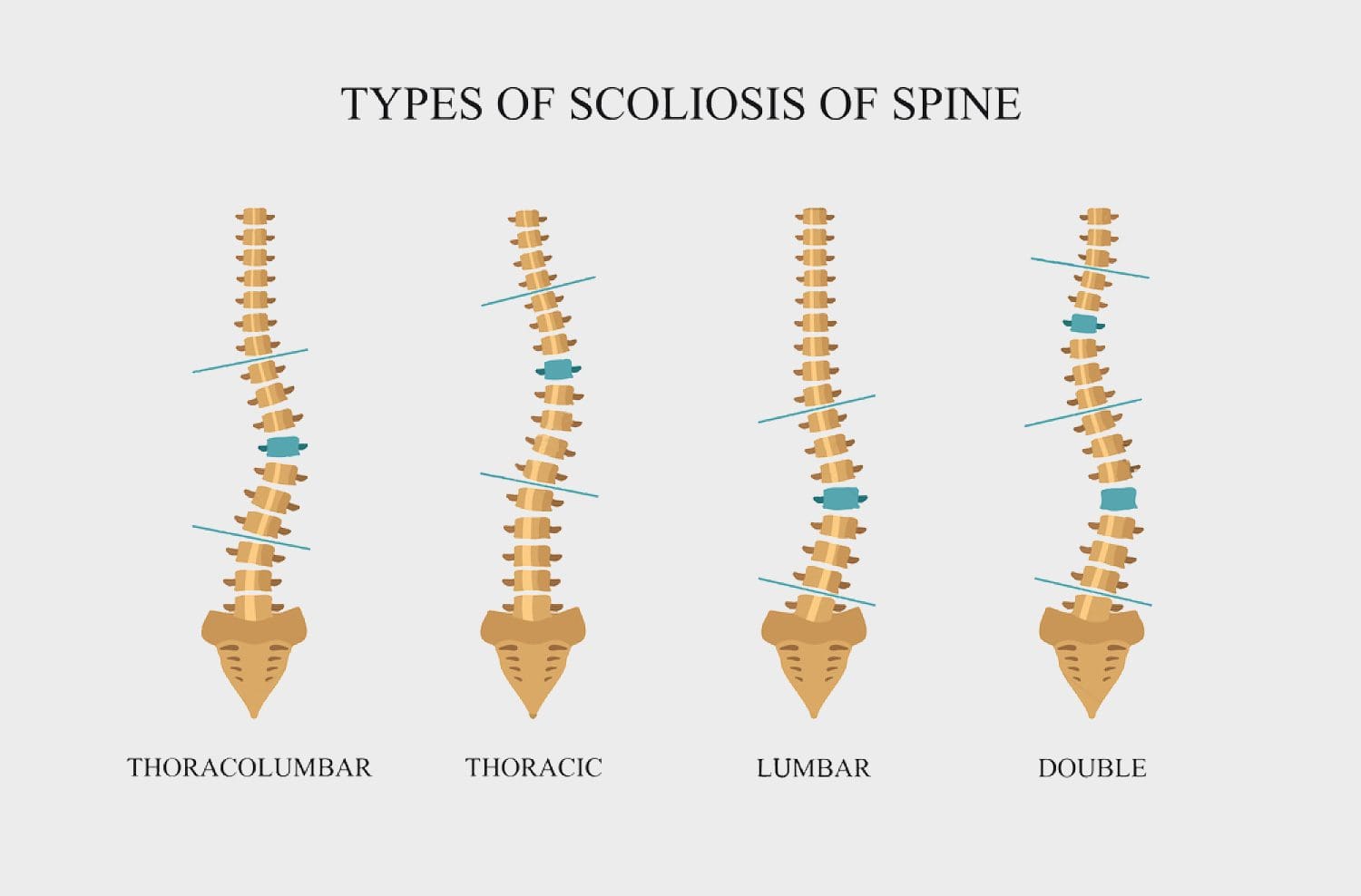 Scoliosis
Scoliosis
- It is more common in females than in males.
- Most cases are mild, but some children develop spine deformities that continue to worsen as they grow. Severe scoliosis can be disabling. A severe spinal curve can reduce the amount of space inside the chest, making it difficult for the lungs to function properly.
- Children that have mild scoliosis are monitored with X-rays to see if the curve is worsening.
- Some children need to wear a brace to stop the curve from worsening.
- Others may need surgery to keep the curve from worsening and to straighten out severe cases.
- Complications of scoliosis include chronic pain, respiratory deficiencies, and decreased exercise capacity.
Symptoms
Scoliosis normally becomes apparent from infancy or adolescence.
Symptoms In Infants
Infants symptoms can include:
- A bulge on one side of the chest
- Baby might lie down consistently curved to one side
- Severe cases can cause problems with the heart and lungs, which leads to shortness of breath and chest pain
Some types of scoliosis can cause back pain but not a great deal.
If left untreated, problems can develop later in life, i.e., impaired heart and lung function.
Symptoms In Adolescents
The most common form of scoliosis appears in adolescence. It is known as Adolescent Idiopathic Scoliosis. It can affect children from the age of ten.
Idiopathic means that there is no known cause.
Symptoms may include:
- The Head is slightly off-center
- The ribcage is not symmetrical because ribs may be at different heights
- If a curve gets worse, the spine also rotates and/or twists in addition to curving from side to side. This causes the ribs on one side of the body to stick out farther on one side.
- Clothes do not hang properly.
- An individual may lean to one side
- One hip is more prominent than the other
- Uneven waist
- Uneven leg lengths
- Uneven shoulders
- The one-shoulder blade that shows to be more prominent than the other
See a doctor if there are signs or symptoms of scoliosis in your child. Mild curves can develop without the parents or child knowing because they appear gradually and most often do not cause pain. In fact, often, teachers, friends, and teammates are the first to notice the abnormal curvature.
Diagnosis
- A doctor will carry out a physical examination of the spine, ribs, hips, and shoulders.
- With the aid of a tool called an inclinometer, or scoliometer, the doctor can measure the degree of the curve.
- The patient may be referred to an orthopedic specialist.
- Imaging scans such as x-rays, CT scans, and MRIs can help assess the curve’s shape, direction, location, and angle.
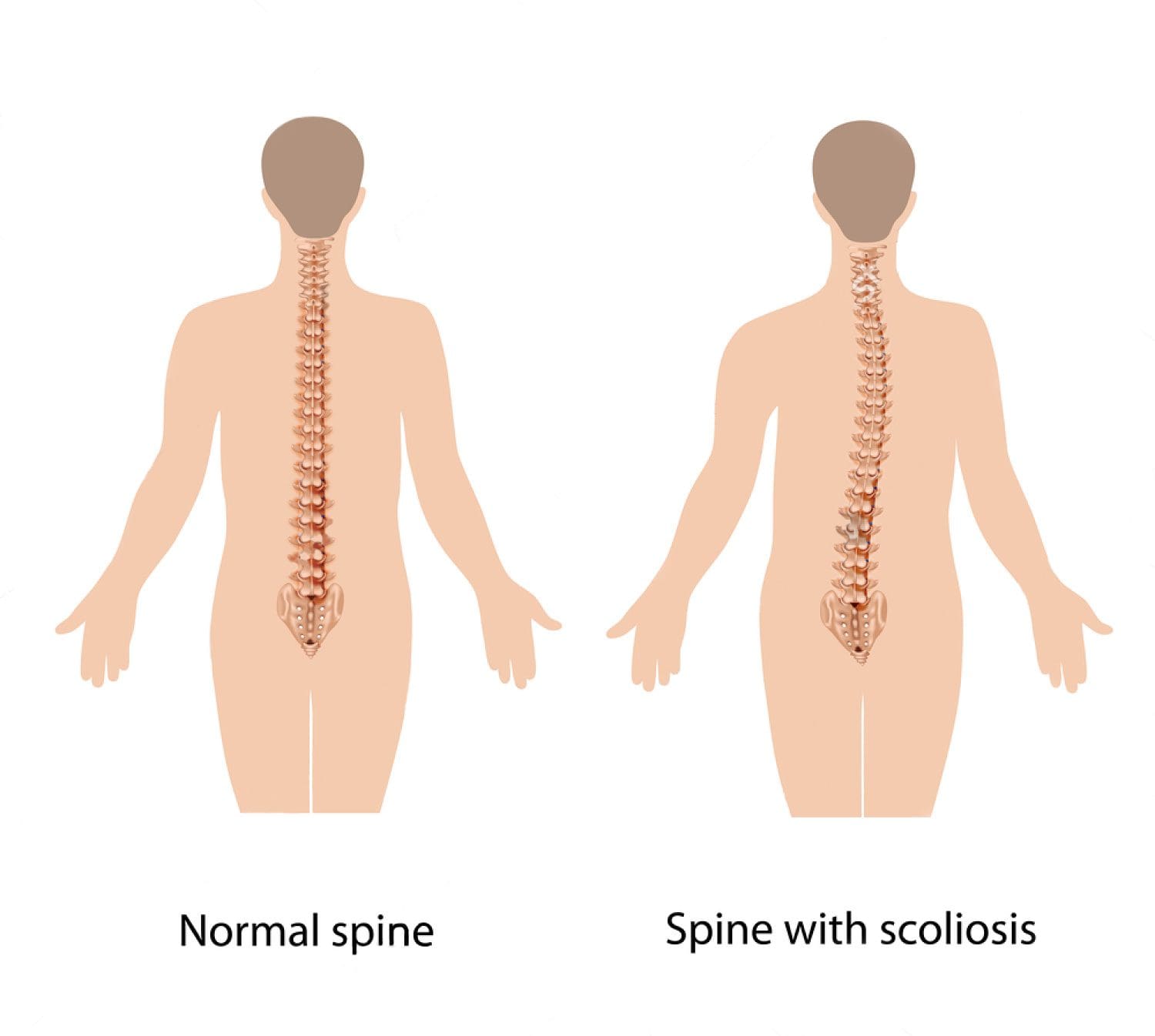 Scoliosis Treatment Options
Scoliosis Treatment Options
A doctor will usually recommend a follow-up every four to six months to monitor the curve at the clinic and with X-rays.
- Bone Maturity: The risk of worsening is lower if the person’s bones have stopped growing. Braces are more effective while bones are still growing. The following factors are considered when deciding on treatment options:
- Curve Position: A curve located in the center part of the spine is more likely to worsen than curves in the lower or upper section.
- Curve Severity: The larger the curve, the greater the risk of it worsening over time. S-shaped curves, also called “double curves,” tend to worsen over time. C-shaped curves are less likely to worsen.
- Sex: Females are more likely than males to have scoliosis that gradually gets worse.
Casting
Casting can be utilized instead of bracing for infant scoliosis to help the infant’s spine go back to its normal position as it grows. This is done with a cast made of plaster of Paris.
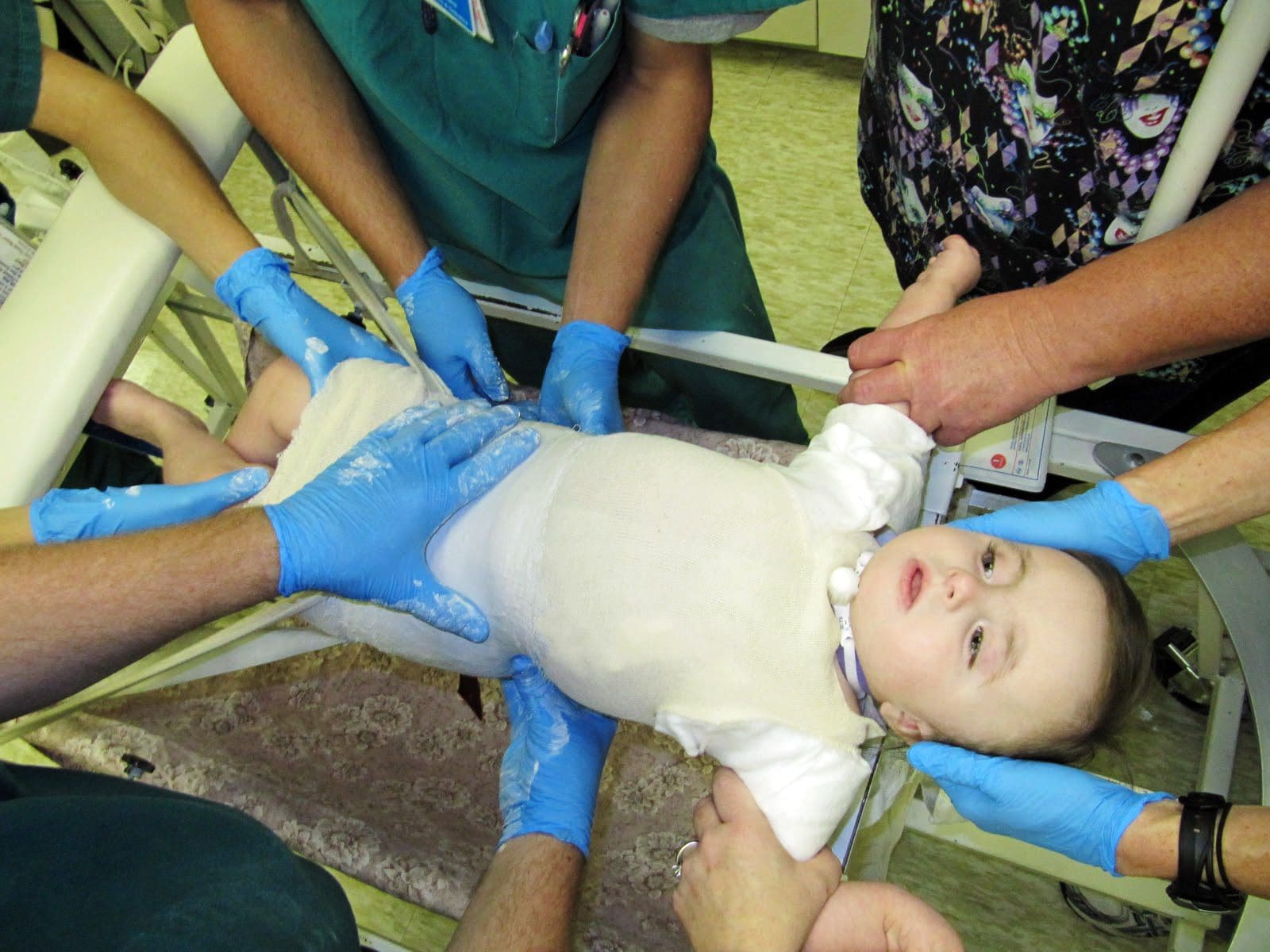 The cast is attached to the outside of the patient’s body and should be worn at all times. Because of the rapid growth of an infant, the cast is changed regularly.
The cast is attached to the outside of the patient’s body and should be worn at all times. Because of the rapid growth of an infant, the cast is changed regularly.
Braces
If a patient has moderate scoliosis and the bones are still growing, a doctor may recommend a brace. This prevents any further curvature but does not cure or reverse it. Braces should be worn throughout the day and at night. The more hours the patient wears the brace, the more effective it is.
Braces do not restrict what a child can do. If the child wants to take part in physical activity, the braces can be taken off.
When the bones stop growing, the braces are no longer used.
There are two types of braces:
- Thoracolumbosacral Orthosis (TLSO): TLSO is made of plastic and is designed to fit snuggly around the body. It is usually not visible underneath clothing.
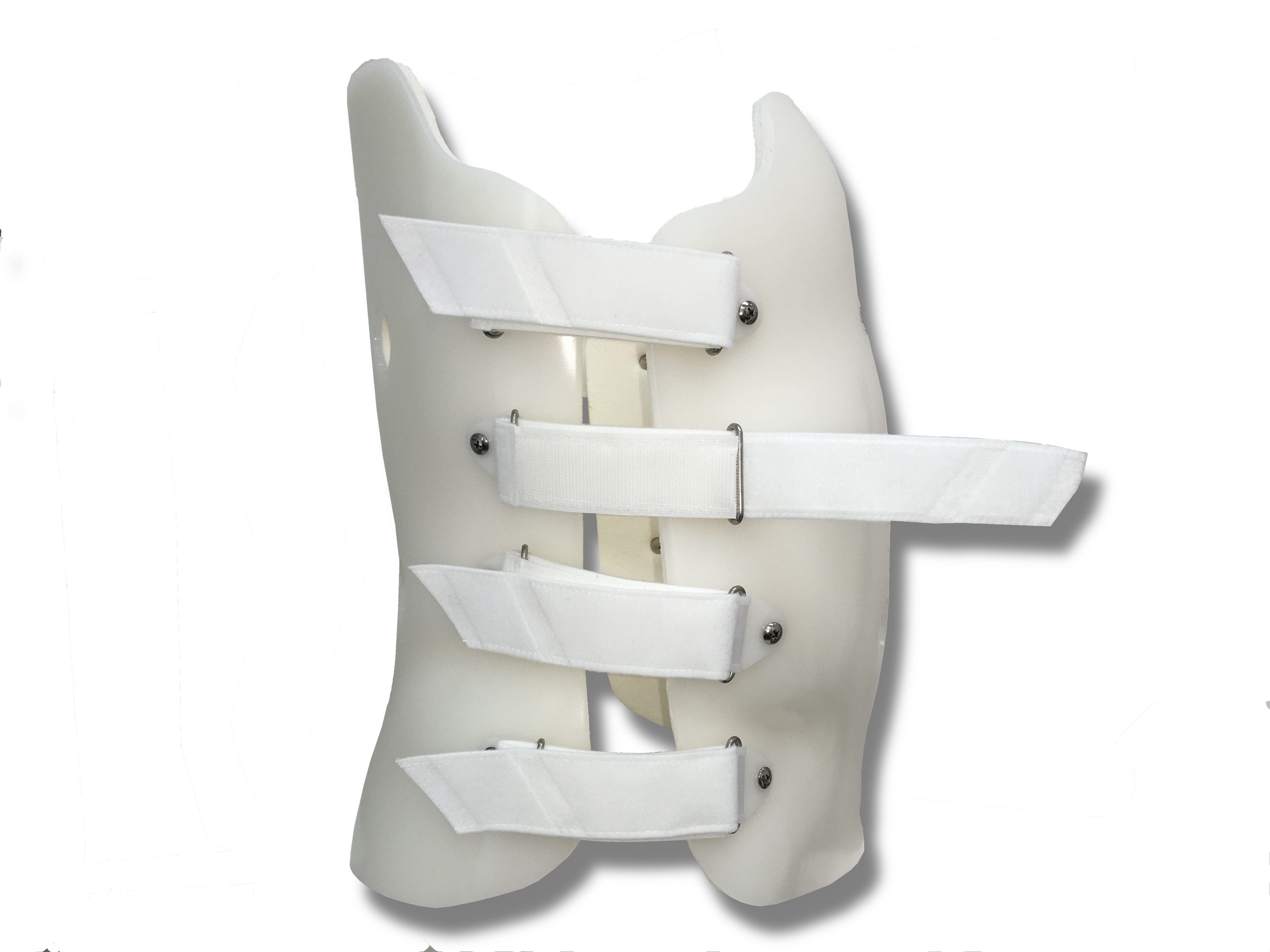
- Milwaukee Brace: This is a full-torso brace with a neck ring with rests for the chin and the back of the head. This type of brace is only used when the TLSO is not possible or not effective.
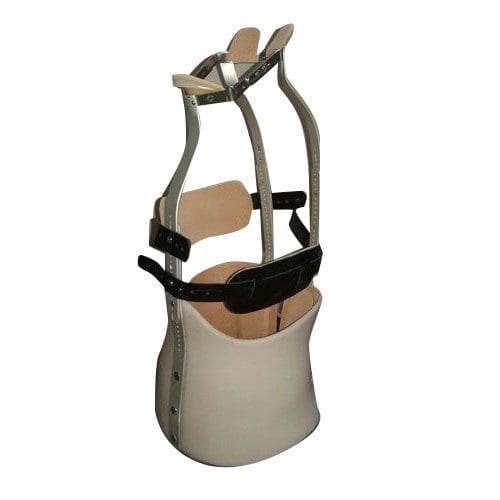
A study found when bracing is used on 10-15-year-olds with idiopathic scoliosis, it reduces the risk of the condition worsening or requiring surgery.
Exercises
Various exercises are suggested, along with various strategies. They all aim to realign the spine, rib cage, shoulders, and pelvis, to achieve normal, proper posture.
A study found that there is growing evidence that exercise can help treat scoliosis. However, more work is needed to find which exercises are the most effective and beneficial.
Surgery
Severe cases can progress over time. A physician may recommend spinal fusion. This surgery reduces the curve of the spine and stops it from becoming worse.
Surgery involves the following:
Bone Grafts: two or more vertebrae (bones of the spine) are connected with new bone grafts. Sometimes, metal rods, hooks, screws, or wires hold part of the spine straight during the bone/s heal.
Intensive Care: the operation lasts 4-8 hours. After surgery, the child is transferred to an ICU (intensive care unit), where they are given intravenous fluid and pain relief. In most cases, the child will leave the ICU within 24 hours but may have to remain in the hospital for a week to ten days.
Recovery: children can usually go back to school after 4-6 weeks and participate in sports, possibly one year after surgery. In some cases, a back brace is needed to support the spine for about 6 months.
The rods are surgically removed when the spine has grown. The patient will return to the hospital every 6 months to have the rods lengthened. This is usually outpatient care, so the patient does not spend the night.
A doctor will recommend spinal fusion if the benefits are believed to outweigh the risks.
The risks include:
- Rod displacement: A rod can move from its proper position, making further surgery necessary.
- Pseudarthrosis: One of the bones used to fuse the spine into place does not fuse properly, leading to mild discomfort and an unsuccessful correction, which could require further surgery.
- Infection: If this happens, it is usually treated with antibiotics.
- Nerve damage: If there is nerve damage, this can lead to mild symptoms, such as numbness in one or both legs, to severe problems, such as paraplegia, which is the loss of all lower body function.
A neurosurgeon may be present during this surgery.
Causes
Possible causes:
- Neuromuscular Conditions: This affects the nerves and muscles and includes cerebral palsy, poliomyelitis, and muscular dystrophy.
- Congenital Scoliosis (Present At Birth): This is rare and occurs because the bones in the spine develop abnormally as the fetus was growing.
- Specific Genes: There is one gene that is thought to be involved in scoliosis.
- Leg Length: If one leg is longer than the other, scoliosis can develop.
- Syndromic Scoliosis: Scoliosis can develop as part of another disease, including neurofibromatosis and Marfan’s syndrome.
- Osteoporosis: This can cause secondary scoliosis due to bone degeneration.
- Other Causes: Bad posture, carrying backpacks or satchels, connective tissue disorders, and some injuries.
Risk Factors
Risk factors include:
- Age: Signs and Symptoms start during a growth spurt before puberty starts
- Gender: Females are at higher risk to develop the condition
- Genetics: Close relative/s with the condition
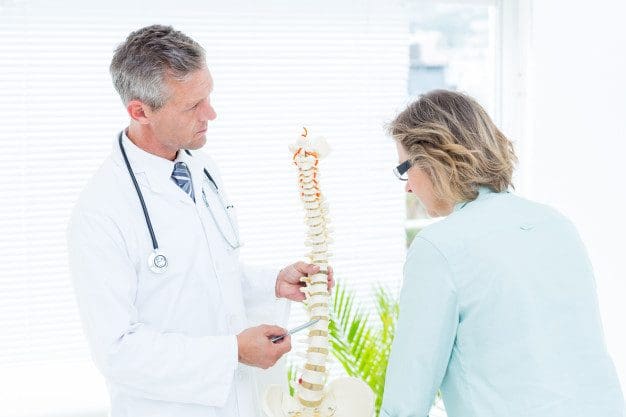 Adult Scoliosis Does Not Mean Surgery Is Needed
Adult Scoliosis Does Not Mean Surgery Is Needed
Adult Scoliosis is defined as a curve in the spine of 10 degrees or more in a person eighteen years or older.
- Many people fear the only course of action is major surgery.
- A small portion of people with scoliosis requires reconstructive surgery.
- Many people with scoliosis manage their symptoms without surgery.
- Often treatment for scoliosis is aimed at relieving symptoms rather than fixing the curve in the spine.
- Treatment might include physical therapy to strengthen/stabilize the spine.
- Chiropractic Treatment which includes manual spinal decompression
- Anti-inflammatory medications or epidural injections could be implemented to relieve pain.
- People that cannot find pain relief from medications or physical therapy could need spinal decompression surgery.
The Spine’s Curve Does Not Tell If Symptoms Will Present Themselves
As we age, our spine begins to deteriorate. It starts to weaken, which may also cause it to curve. Some people never have any symptoms. While others experience leg pain, numbness/tingling when walking, and/or back pain.
Diagnosis
The most important part of scoliosis treatment begins with an accurate diagnosis. Adult scoliosis can sometimes be diagnosed by only observing the back of the curve is severe and has obviously changed the spine’s structure. But the best way to identify adult scoliosis is withstanding X-rays.
Adults: Two Types Of Scoliosis
Adult scoliosis falls into two categories:
Adult Idiopathic Scoliosis: With this type, patients have had scoliosis since childhood or as teenagers, and then they grow into adulthood. However, in some cases, they were not diagnosed until adulthood. There is no known cause of idiopathic scoliosis, but there is a great deal of genetic work to answer this question.
Adult “De Novo” or Degenerative Scoliosis: This type develops in adulthood. Degenerative scoliosis develops as a result of disc degeneration. This is the normal wear and tear of the lower back from the aging process, leading to developing a curve in the spine. As the disc degenerates, it loses height. If one side of the disc degenerates faster than the other, the disc starts to tilt. As the tilting continues, more pressure is placed on one side of the spine, and gravity causes the spine to bend and curve. The more discs that degenerate, the more the spine starts to curve.
Adult Scoliosis Symptoms
Adult scoliosis symptoms can include:
- Back Pain
- Leg Length Difference
- Uneven Hips
- Abnormal Walking Motion
- Both types of adult scoliosis can progress over time
- If the curve reaches 30 to 40 degrees, the deformity can be noticed from a hump or bump in the affected area.
- Curves that reach 50 degrees or more may progress quicker than those that are less than 50 degrees.
- Adults with large curves may experience back pain
- If the curve goes above 80 degrees, this could create shortness of breath during activities. Shortness of breath comes from the effect on lung function.
- Adult scoliosis rarely causes paralysis or other severe neurologic problems, but it can be associated with lumbar stenosis (narrowing the spinal canal, where the nerves are located). This can result in nerve irritation, leg pain, and weakness.
- A Pitched Forward Posture can also develop, which can cause a patient not to stand up straight. This can occur with scoliosis and with age as the discs degenerate.
Adult Scoliosis Treatment
Adult scoliosis treatment is individualized and based on the specific symptoms and age of the patient.
- Many patients have scoliosis and have minor symptoms and live with it without treatment.
- Patients with predominant symptoms of back pain would typically be treated with physical therapy. Patients with back pain and leg pain may benefit from injection treatment to help relieve the leg pain.
- If lumbar stenosis (narrowing of the spinal canal) is present and unresponsive to non-surgical treatment, decompression(removing bone and ligaments pressing on the nerves) may be recommended.
- The fusion is recommended to prevent the curve from progressing when the spine is destabilized by the bone removal necessary to decompress the nerves. Fusions are usually accompanied by a metal rod and screw placement into the spine to help correct and stabilize scoliosis and help the bone heal or fuse together. The length of the fusion, or the number of spine levels included, depends on the type of scoliosis and the area of the spine involved. If the scoliosis is greater than 30 degrees, a fusion procedure will most likely be recommended along with the decompression.
Non-Operative Corrective Treatment
Correcting scoliosis in adults usually doesn’t require surgery. Many scoliosis treatments offered are non-operative, including physical therapy, chiropractic treatment, and spinal injections. Non-operative treatment options are utilized to help treat scoliosis pain and maximize function.
- Chiropractic Treatment
- Physical Therapy
- Spinal Injections
Operative Corrective Treatment
A specialist may recommend surgery as a treatment option for adults if non-operative treatments do not relieve the pain or symptoms. Surgery may also be needed for patients whose curves are progressing or are starting to experience symptoms, i.e., numbness, weakness, or pain. In general, curves greater than 45 degrees are best treated with surgery.
The goal through surgery is to first remove the pressure on the nerves. Scoliosis treatment through surgery offers the least invasive and safest procedure while relieving scoliosis pain and preventing the curvature from getting worse.
Exercise Is Possible With Adult Scoliosis
Many who have scoliosis are told to limit activities. However, physical activity can help people with scoliosis, as it is less likely to be symptomatic. If overweight, weight loss can help reduce scoliosis symptoms. And it is important to monitor bone density and seek treatment if osteoporosis is present.
Chiropractic Scoliosis Treatment
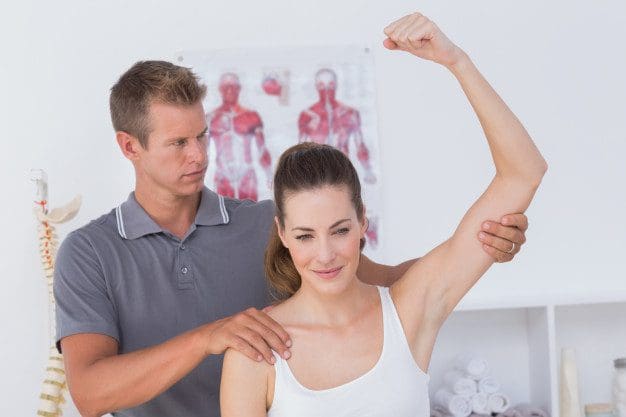 Chiropractors look for immovable or stuck joints in the spine and try to realign them and get them moving again. With scoliosis, it’s not joint mobility that is the issue. It is how the location of the joints is not properly aligned. Scoliosis treatment with traditional chiropractic can actually put more pressure on the spinal joints, aggravating the surrounding nerves and leading to scoliosis becoming worse. Therefore, a chiropractor that is trained to diagnose and perform scoliosis treatment should be sought out.
Chiropractors look for immovable or stuck joints in the spine and try to realign them and get them moving again. With scoliosis, it’s not joint mobility that is the issue. It is how the location of the joints is not properly aligned. Scoliosis treatment with traditional chiropractic can actually put more pressure on the spinal joints, aggravating the surrounding nerves and leading to scoliosis becoming worse. Therefore, a chiropractor that is trained to diagnose and perform scoliosis treatment should be sought out.
- X-rays allow doctors to measure the three-dimensional curve of the patient’s spine to determine the best method of treatment.
- Chiropractic treatment for scoliosis involves regular adjustments with hands or a device. To realign the muscles, bones, and joints.
The joints of the spine need to be repositioned as a priority. For any long-term benefits, there is a lot more that needs to accompany these repositioning adjustments. The muscles need to be relaxed, and the brain needs to be retrained to use the muscles and spinal joints differently than what the spine was accustomed to. For scoliosis treatment to be effective, all of these things need to happen together. This type of scoliosis treatment consists of massages, stretches, and exercises, along with scoliosis-specific adjustments.
Specific Chiropractic Scoliosis Treatment
Specific scoliosis treatment goes outside of the traditional guidelines to stabilize the curve. Aiming to correct the spine into a classic spinal curve gradually, scoliosis-specific adjustments are precise and gentle. This technique can help people from all walks of life. People who have already had surgery and don’t want it again, people trying to avoid surgery, and teenagers who don’t want to wear a brace.
Most people think of scoliosis as a sideways curve of the spine, but it’s a bit more complicated.
The spine should have three curves:
- Cervical Lordosis that points forward in the neck,
- Thoracic Kyphosis that points backward in the middle of the back
- Lumbar lordosis that points forward in the low back
Scoliosis forces the spine in a different direction for one or more of these three natural curves.
People with scoliosis are, for all intents and purposes, double-jointed in the neck. This hypermobility makes the joints unstable and puts them at a higher risk of injury and dislocation if not treated gently. There is no twisting or turning of the neck in scoliosis-specific adjustments. Scoliosis-specific adjustments use a precision mechanical adjusting instrument to adjust the neck and other joints of the body.
The first step to restoring the proper curves in the spine is to re-center the head. While the patient is sitting up, and adjusting instrument is used to deliver precise but gentle force into the neck’s bones. This force works to coax the neck into the ideal position. Adjustments can also be performed on the back and hips, which depends on the measurements of the spine from the x-rays.
Some chiropractors claim to be trained to diagnose and treat scoliosis; however, their knowledge is limited. It is important to start a dialogue with your doctor to ensure you receive care from a chiropractor trained to diagnose and treat scoliosis. If the chiropractor is not producing the results promised or adjusting the treatment to yield them, it may be time for a new chiropractor.
Outside of the chiropractic adjustments, an individual needs to spend one to two hours a day doing exercises to achieve optimal results. Exercises include balance training, strength training, and for severe cases, the scoliosis traction chair elongates the spine and uncovers the nerves with vibration. As the curve decreases, one can also decrease the exercises, as well.
Scoliosis Treatment & Chiropractic
Assessing New Patients
We are often asked what doctors are looking for when assessing a new patient with scoliosis. How much will we be able to help? The answer is different due to each patient’s unique case. Here are a few general signs we look for.
Spinal Rigidity
We look at how rigid the spine is that we will be working with. This will indicate how much upfront work needs to be done before effectively starting repositioning the spine.
We focus on more than just discs, muscles, and bones. We factor in the spine’s nerves, specifically, how much tension is being placed on these nerves. A theory of why scoliosis develops is to relieve tension being placed on the nerves of the spine. While there is no proof, we see it as a major player, not just in the spine’s shape but also in the quality of life. Alleviating nerve tension can help you feel better and quicker as you move forward, creating the shape of your spine.
Sensorimotor Integration
Sensorimotor integration (SMI) is the term for how well the brain can communicate with the body. Miscommunication between the brain and body can lead to all sorts of issues, which includes scoliosis. Scoliosis treatment requires retraining the brain to use the body, specifically the spine, in a way/s that it has grown unaccustomed to.
This involves a series of balance-related tests to see how well things are aligned from the outset. The tests are repeated throughout treatment to chart improvement. This is a major aspect of treatment that many traditional chiropractors overlook when it comes to scoliosis treatment.
Dedication
The greatest factor we look at when determining how much progress we can make with a new patient is the level of commitment that a patient is willing to put in.
Like all types of treatments, part of the treatment plan takes place at home. The same is true with scoliosis treatment. If you are dedicated to a treatment plan, you are far more likely to reap the benefits.
You need to be your own advocate. What matters to you, makes the most sense for your lifestyle, and what do you want to achieve? It is necessary to establish a dialogue with your doctor and chiropractor to empower yourself and control your spinal health.
Chiropractic Clinic Extra: Non-Surgical Option
Post Disclaimer
Professional Scope of Practice *
The information on this blog site is not intended to replace a one-on-one relationship with a qualified healthcare professional or licensed physician and is not medical advice. We encourage you to make healthcare decisions based on your research and partnership with a qualified healthcare professional.
Blog Information & Scope Discussions
Welcome to El Paso's Premier Wellness and Injury Care Clinic & Wellness Blog, where Dr. Alex Jimenez, DC, FNP-C, a board-certified Family Practice Nurse Practitioner (FNP-BC) and Chiropractor (DC), presents insights on how our team is dedicated to holistic healing and personalized care. Our practice aligns with evidence-based treatment protocols inspired by integrative medicine principles, similar to those found on this site and our family practice-based chiromed.com site, focusing on restoring health naturally for patients of all ages.
Our areas of chiropractic practice include Wellness & Nutrition, Chronic Pain, Personal Injury, Auto Accident Care, Work Injuries, Back Injury, Low Back Pain, Neck Pain, Migraine Headaches, Sports Injuries, Severe Sciatica, Scoliosis, Complex Herniated Discs, Fibromyalgia, Chronic Pain, Complex Injuries, Stress Management, Functional Medicine Treatments, and in-scope care protocols.
Our information scope is limited to chiropractic, musculoskeletal, physical medicine, wellness, contributing etiological viscerosomatic disturbances within clinical presentations, associated somato-visceral reflex clinical dynamics, subluxation complexes, sensitive health issues, and functional medicine articles, topics, and discussions.
We provide and present clinical collaboration with specialists from various disciplines. Each specialist is governed by their professional scope of practice and their jurisdiction of licensure. We use functional health & wellness protocols to treat and support care for the injuries or disorders of the musculoskeletal system.
Our videos, posts, topics, subjects, and insights cover clinical matters and issues that relate to and directly or indirectly support our clinical scope of practice.*
Our office has made a reasonable effort to provide supportive citations and has identified relevant research studies that support our posts. We provide copies of supporting research studies available to regulatory boards and the public upon request.
We understand that we cover matters that require an additional explanation of how they may assist in a particular care plan or treatment protocol; therefore, to discuss the subject matter above further, please feel free to ask Dr. Alex Jimenez, DC, APRN, FNP-BC, or contact us at 915-850-0900.
We are here to help you and your family.
Blessings
Dr. Alex Jimenez DC, MSACP, APRN, FNP-BC*, CCST, IFMCP, CFMP, ATN
email: coach@elpasofunctionalmedicine.com
Licensed as a Doctor of Chiropractic (DC) in Texas & New Mexico*
Texas DC License # TX5807
New Mexico DC License # NM-DC2182
Licensed as a Registered Nurse (RN*) in Texas & Multistate
Texas RN License # 1191402
ANCC FNP-BC: Board Certified Nurse Practitioner*
Compact Status: Multi-State License: Authorized to Practice in 40 States*
Graduate with Honors: ICHS: MSN-FNP (Family Nurse Practitioner Program)
Degree Granted. Master's in Family Practice MSN Diploma (Cum Laude)
Dr. Alex Jimenez, DC, APRN, FNP-BC*, CFMP, IFMCP, ATN, CCST
My Digital Business Card


